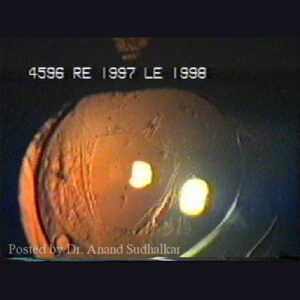Cornea: Complicated cases
December 2021
by Ellen Stodola
Editorial Co-Director

Source: Amy Lin, MD
A graft detachment is a fairly common complication that can occur when doing DSAEK and DMEK. Amy Lin, MD, and Francis Price, Jr., MD, discussed when detachments can happen and how to address them.
Dr. Lin said that most cornea specialists have likely experienced a graft detachment multiple times in their career. She said it seems to happen more frequently when a physician is first learning to do DSAEK and DMEK. “It has to do with more manipulation of the donor [tissue],” she said, adding that this can lead to a loss of more endothelial cells during surgery. There are instances where there was a known excessive amount of manipulation during surgery and there may be a higher chance of graft detachment postoperatively. After the disappearance of the air or gas bubble is when a graft will typically detach, Dr. Lin said.
With graft detachment in DSAEK, Dr. Price said it’s usually almost a complete detachment. “That’s something you should be able to head off in most cases, and if it’s detaching more, you need to put in air,” he said.
Dr. Price usually reserves DSAEK for complicated cases, those where he’s concerned about the DMEK dislocating into the back of the eye. “If we have a case where we’re worried about it going into the back of the eye, we will typically put one fixation suture in,” he said, noting that he will do this either with a suture pull-in technique, or once the graft is in the eye, he’ll put in one stitch.
“It’s important to remember to never put in more than one fixation stitch,” Dr. Price said. Those who initially began to use posterior grafts attempted to use multiple fixation stitches, he said, and that can pull the donor away from the apex of the recipient cornea. It pulls it into a straight line and doesn’t curve, so they won’t attach properly if you have more than one fixation suture. He also recommended not making the fixation stitch overly tight.
When there’s a DSAEK dislocation, Dr. Price recommended getting a good air fill. There will typically be a pressure in the 30s for 10 minutes, then you can get rid of most of the air so you don’t get a pupillary block. “If the DSAEK graft is partially detached, it will often reattach on its own if you give it time,” Dr. Price said. “That stroma wants to attach.”

Source: Francis Price Jr., MD
A DMEK detachment is different, he said. If the DMEK graft detaches completely, you’ll likely have to take the patient back to the OR, restain with trypan blue, and go through the unfolding process.
Dr. Price said he reinjects air with DMEK grafts when the detachment is increasing in size, if it’s affecting the vision so you have edema in the center, or if it’s an area of edema where you’re getting some bullae and it’s bothering the patient. “It’s very subjective with DMEK as to the percentage of reinjection of air or gas among different surgeons,” he added, noting that his practice tends to reinject air more often because they’ve shown that one reinjection of air doesn’t affect cell count. “If we have someone bothered by edema, we reinject, and that’s about 20% of the time for virgin eyes,” Dr. Price said.
When doing DSAEK, Dr. Lin said she will typically put in an air bubble at the end and that will resolve within 1–2 days after surgery. “If a graft detachment is going to happen, it will usually be noticed postop day 1 or postop week 1,” she said. Occasionally, the graft may be attached in the first week, but if there is severe edema present, it may be a sign that there is a low number of endothelial cells, and the graft could detach a few weeks later.
When doing DMEK, Dr. Lin generally uses SF6 gas in the eye instead of air, which she said lasts longer. “Graft detachment may be more common with DMEK than DSAEK,” Dr. Lin said. “I put the SF6 gas in at 20% concentration, and it typically lasts at least a week, and I have the patient positioned on their back longer so the gas bubble can support the DMEK.” Once the gas bubble leaves, the DMEK should be in place, she said.
With DMEK, you can either have a partial detachment or full detachment, Dr. Lin said. If there is a partial detachment, she recommended rebubbling to try to get the graft to reattach. If there is a full detachment, it’s usually scrolled up, she said, noting that she would either repeat DMEK or go with DSAEK rather than trying to rebubbble a detached DMEK graft.
With a DSAEK detachment, whether partial or full, Dr. Lin said she will put in more air.
Dr. Lin usually does rebubbling using topical anesthesia and trying to either get in through a prior paracentesis with a cannula or using a 27- or 30-gauge needle through the limbus to put in more air. She has done rebubbling at the slit lamp but said this tends to be a bit trickier.

Source: Francis Price Jr., MD
Special considerations
Dr. Price noted that one group in which he’s more likely to reinject air, and the only group in which he uses long-acting gas routinely, are the eyes that have had previous PK because of the irregular surface that you get with the edge of the PK wound.
A lot of these grafts don’t stick well, he said. “If you have large diameter PK, you can first make your DMEK donor smaller than the diameter of the PK, and you’ll probably be OK.” But if the DMEK graft is going to be larger than the PK diameter, there will be a higher likelihood of partial or increasing detachment. “What we’ve found is that with a larger diameter DMEK graft than the previous PK, you have to reinject air multiple times. We go to long-acting gases and try to leave 80–90% gas fill to try to prevent them from detaching in the first place and to give it time to cover up irregular surfaces from PK,” Dr. Price said.
Another patient group to consider carefully are those with soft eyes or hypotony. If the pressure is less than 8, Dr. Price said he will usually choose DSAEK. If the patient truly has hypotony, with pressure less than 5–6, he would recommend PK. The reason for this is if the eye is too soft, each time the patient blinks, they’re going to indent the cornea and that will make the graft come off.
Patients with a large iris defect may also have problems. Dr. Price said it’s possible in these cases to lose the air because when the patient sits up, it could go to the back of the eye. In some of these patients, you might want to consider DSAEK, he said.
Additionally, in patients with filters, especially tube shunts, there is an opening that the air can go up into. If it’s an inferior tube, this might not be a big deal, Dr. Price said, but if it’s a superior tube, you may have to either put in a reinjection of air once the air goes up in order to fill the anterior chamber or try long-acting gas. Another problem with filters, he said, is the air can block the filter and pressure can shoot up in the eye.
He makes sure to tell patients not to rub or push on the eyes because that will cause a detachment. While detachments can occur during surgery, generally, it is a postop complication.
Dr. Price noted that it’s important to be careful during surgery if you have a case of an artificial iris. If you’re looking through a coaxial microscope, you get the impression you have a normal angle, which you don’t because there’s nothing in the angle, he said. The angle area goes out 12–13 mm, and artificial irises are typically 9–11 mm in diameter. If you put a DSAEK graft into one of those eyes and let go before putting an air bubble under it, it can fall into the back of the eye because it never got attached, he said. But generally during surgery, you shouldn’t get a detachment once you’ve filled the anterior chamber with air.
Dr. Lin also highlighted considerations for patients with comorbidities or previous surgeries. She mentioned that she has found a higher rate of graft detachments with DSAEK in patients with comorbidities such as tube shunts, trabeculectomies, aphakia, or iris defects and anterior synechiae. With trabeculectomy and tubes, the air tends to escape faster than normal. If the patient has had a prior trabeculectomy or tube shunt, Dr. Lin will leave a much larger air bubble in the eye, maybe 90–100% air fill rather than the 80% she typically uses.
Dr. Lin said she will discuss the potential problem of detachment with patients preoperatively. “I tell them that if it should happen, I can typically rebubble the graft in the office, or if that doesn’t work, we could do it in the OR, or worst case, repeat the transplant,” she said.
About the physicians
Amy Lin, MD
Associate Professor of Ophthalmology
John A. Moran Eye Center
University of Utah
Salt Lake City, Utah
Francis Price, Jr., MD
Price Vision Group
Indianapolis, Indiana
Relevant disclosures
Lin: None
Price: None
Contact
Lin: amylin78@gmail.com
Price: fprice@pricevisiongroup.net



